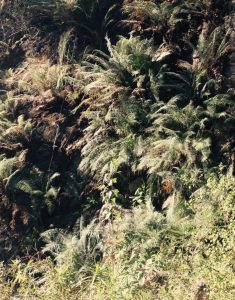By Tommy Clarkson from the May 2015 Edition
“They call me ‘Chicken”
Alex Banasik is a pal of mine from Clive, Iowa a suburb of Des Moines where he owns and operates the Down Under Bar and Grill. He has a condo here in Manzanillo and comes down to relax when he can find the time to do so. But, I believe we are in full agreement that his visits are too few and way too far between!
However, when he is here, he’s always ready for the unexpected and seems to enjoy accompanying me in my “trundles to the interior”. This trip, taken in midApril, started out through the hilly, twisted road that divides Chan Diablo and then wound its way through assorted other small villages and colonias such as Vela de Camotlan and San Jose’ de Lumber ultimately terminating in the general La Rosa area.

Driving slowly, enroute, we found a new species of cliffside dwelling fern that had, heretofore, not been among Ola Brisa Garden’s collection of this plant family.
While parked on the road edge we paused to savor the absolute absence of all manner of not only urban noise, but also any sound emanating from humanity. The pure, peaceful, quiet of nature with only an occasional bird’s song was, for city dwellers such as we, simple, unadulterated bliss.

Finally, we forced ourselves to leave this wondrous absence of sound, drove on a ways further on the winding, two-lane and then stopped at one of my “girlfriend’s”. (That’s what Patty calls my numerous “little old ladies” with whom I exchange plants during these excursions.)
Though I called out to her repeatedly, sadly this time, she wasn’t home. But soon a young man emerged from the casa behind her home. In English a bit better than my Spanish (which doesn’t take much) he introduced himself saying, “They call me Chicken.”

After explaining my mission, I left for my elderly “Lady Friend” what I’d brought for her: a small variegated Oyster Plant and two baby “Giants” a Giant Crinum, from the island states of Seychelles and Mauritius in the Indian Ocean and a Giant Aloe from Barbados. With a shy, sincere smile, he assured me that he’d get them to her. We expressed our thanks, re-mounted “Shane the Jungle Truck” and continued on our leisurely meander.

After stopping for pictures of a flowering, Pink Trumpet Tree (Tabebuia rosea) and a multi-podded, Earpod Tree (Enterolobium cyclocarpum) we proceeded on to the casa of another of my country friends where he, his wife and aged mother met and greeted us.
There, beneath a grove of banana trees, Alex marveled at the Curcuma phaeocaulis flowers and I showed him their velvety leaf undersides. (For more on this amazing plant that you’d never expect to find in the middle of Colima, Mexico, see my “ROOTS” article on our site at: www.olabrisagardens.com)
Then, our host who had apparently determined that we required nourishment, proceeded to husk a couple of small ears of fresh corn, impaled one ear at a time onto a rough, bent skewer and roasted them over the charcoal heat emanating from his family’s ancient appearing, clay oven

Once he’d decided that they were ready, he carefully pulled the hot, blackened kernel, ears away from the fire, wrapped them in the green husks and presented them to us for consumption.
As an old Kansas farm kid, I had learned many years ago to enjoy the tough, chewiness of field corn . . . sans butter, salt and/or pepper! In turn, good sport that Alex is though living most of the year in Iowa, the very home of the best sweet corn in the world – he indicated appreciation and, too, munched away!

To wash it down we were provided a fruit juice concoction of unknown origin. A bit tart with a flavor and slight unrecognizable odor, it went down equally well! (Such is the nature of wonderful, kind hospitality I encounter with every trip I take into the Mexican countryside!)
Inside this small thatched structure, in which we stood, with its black, smoke-sooted roof, we observed a hanging wire basket of truly country-fresh, eggs collected from the hens that cackled and picked at the bare dirt outside, as well as shreds of beef jerky that hung on a line over the clay oven to dry.
Next, following our noses, we threaded our way through the vegetation a hundred feet or so beyond their home, over to a work area from whence a sweet smoky aroma emanated. There we watched several men hack apart huge, Agave “pineapples” that had been slow cooking” in preparation for making tequila. Grinning, they cut off and gave us large, brown chunks on which to chew. It was of an interesting (not unpleasant) texture and taste and we nibbled on them all the way home. But, as concerns country munchies, I had to draw the proverbial line of “no” when offered a three inch, still alive, caterpillar! It was, I believe, the same variety but the Great-Grand-Daddy of them all – that one often finds in the bottom of bottles of Mezcal.
In gracious and unnecessary reciprocation for the plant “babies” brought to them from our gardens, we were then rewarded with kind gifts of a new (to me) species of armed bromeliad and a very large padded cactus of a sort I’d not seen before.
So, appetites sated, two new garden succulents carefully ensconced in the bed of the truck and pockets full of new experiences now tucked into our memories, in haltingly faulty Spanish we strove to indicate our appreciation and climbed back aboard Shane. During the drive homeward to stop lights, gringo fast food chains and the general cacophony of the city, we mulled the morning over, compared our lives to theirs in appreciation for both and heartily agreed that it had been a day well spent
Download the full edition or view it online
Manzanillo Sun’s eMagazine written by local authors about living in Manzanillo and Mexico, since 2009





You must be logged in to post a comment.